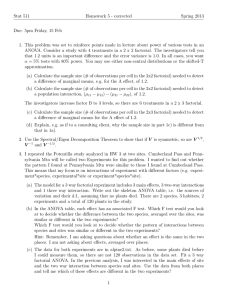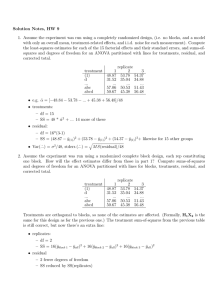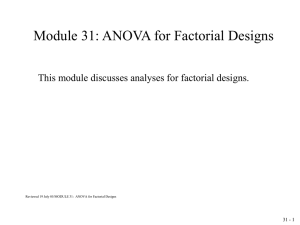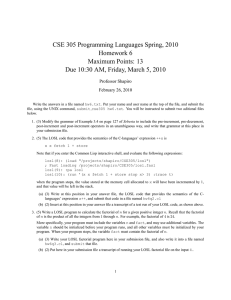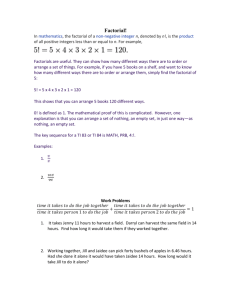STAT 512 Homework Assignment 9: Due in class, Friday, November... Here are data for a 2
advertisement
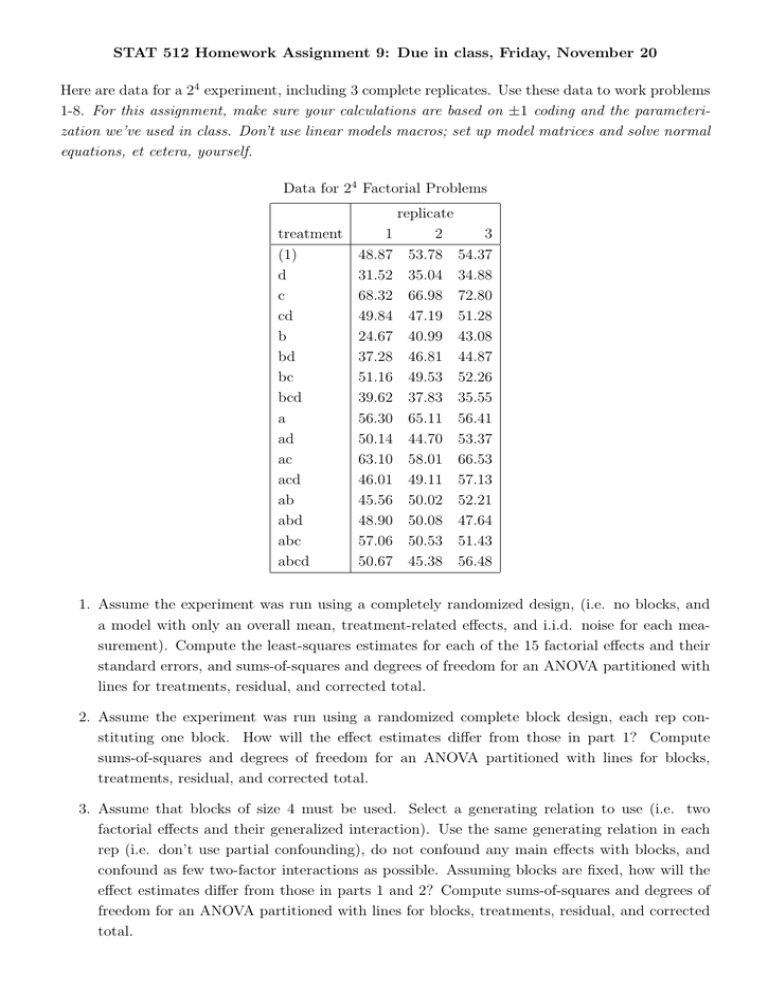
STAT 512 Homework Assignment 9: Due in class, Friday, November 20 Here are data for a 24 experiment, including 3 complete replicates. Use these data to work problems 1-8. For this assignment, make sure your calculations are based on ±1 coding and the parameterization we’ve used in class. Don’t use linear models macros; set up model matrices and solve normal equations, et cetera, yourself. Data for 24 Factorial Problems replicate treatment 1 2 3 (1) 48.87 53.78 54.37 d 31.52 35.04 34.88 c 68.32 66.98 72.80 cd 49.84 47.19 51.28 b 24.67 40.99 43.08 bd 37.28 46.81 44.87 bc 51.16 49.53 52.26 bcd 39.62 37.83 35.55 a 56.30 65.11 56.41 ad 50.14 44.70 53.37 ac 63.10 58.01 66.53 acd 46.01 49.11 57.13 ab 45.56 50.02 52.21 abd 48.90 50.08 47.64 abc 57.06 50.53 51.43 abcd 50.67 45.38 56.48 1. Assume the experiment was run using a completely randomized design, (i.e. no blocks, and a model with only an overall mean, treatment-related effects, and i.i.d. noise for each measurement). Compute the least-squares estimates for each of the 15 factorial effects and their standard errors, and sums-of-squares and degrees of freedom for an ANOVA partitioned with lines for treatments, residual, and corrected total. 2. Assume the experiment was run using a randomized complete block design, each rep constituting one block. How will the effect estimates differ from those in part 1? Compute sums-of-squares and degrees of freedom for an ANOVA partitioned with lines for blocks, treatments, residual, and corrected total. 3. Assume that blocks of size 4 must be used. Select a generating relation to use (i.e. two factorial effects and their generalized interaction). Use the same generating relation in each rep (i.e. don’t use partial confounding), do not confound any main effects with blocks, and confound as few two-factor interactions as possible. Assuming blocks are fixed, how will the effect estimates differ from those in parts 1 and 2? Compute sums-of-squares and degrees of freedom for an ANOVA partitioned with lines for blocks, treatments, residual, and corrected total. 4. Repeat the previous part, but under the assumption that the blocks have been selected randomly. With this form of analysis, all factorial effects can be represented as “treatments” in the ANOVA, but not all will be compared to the same denominator mean square. How will the effect estimates differ from those in previous parts? Compute sums-of-squares and degrees of freedom for an ANOVA partitioned with lines for confounded effects, unconfounded effects, and residual terms appropriate for each of them. 5. Now assume that blocks are fixed, but select a different generating relation for each rep (i.e. use partial confounding) in such a way that no main effect is used, and at least 2/3 information is available for each interaction. Compute the least-squares estimates for each of the 15 factorial effects and their standard errors, and sums-of-squares and degrees of freedom for blocks, partially confounded effects, unconfounded effects, residual, and corrected total. 6. Pretend now that only 8 measurements could be made in the entire experiment. Do this by selecting a single factorial effect, splitting replicate number 1 into two blocks, and ignoring one of the blocks. What “strings” of factorial effects can be estimated from your fractional factorial? Compute these estimates. 7. Now suppose this “half-rep” extends throughout all 3 rep’s; you have only 8 treatments represented in the design, but each of these give you 3 measurements in an unblocked design. What are the least-squares estimates of the 7 estimable effect strings, and the sum-of-squares and degrees of freedom for residual variation in an ANOVA. 8. Continuing the last part, suppose these 24 observations were obtained in a blocked experiment, with each rep constituting one block. (Each block has the same 8 treatments.) What effect will this have on the estimates of the 7 estimable effect strings? CADEompute the sum-of-squares and degrees of freedom for residual variation, assuming fixed blocks and no block-by-treatment interaction. 9. Finally, consider a 25 problems (not the one discussed above) in which effects BCE and ADE are used as “splitting” contrasts to divide treatments into groups of size 8. Select the group of 8 treatments for which BCE is -1 for all treatments and ADE is +1 for all treatments for an unreplicated fractional factorial experiment. • List the treatments (by name, e.g. “abd”) that are included in this fraction. • List the effect strings that contain main effects and are estimable based on this fraction. • Double this experiment by adding a second fraction of the same size, generated by the same factorial effects with different signs. Select the second fraction to maximize the resolution of the resulting combined design. Write the full generating relation for this second fraction (including signs and generalized interactions). • Taken together, these two fractions form a 1/2 fraction. List all effect strings that contain main effects and can be estimated from this design. Suppose the two smaller fractions must be treated as blocks in this overall design; which of the individual effects or effect strings (if any) are confounded with blocks in this design?
